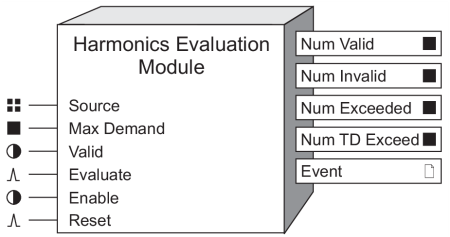Harmonics Evaluation Module
This module provides statistical data which can be used to evaluate harmonics and inter-harmonics standards compliance.
Module icon
![]()
Overview
The Harmonics Evaluation Module receives its input from an FFT module (either voltage or current), analyzes the harmonics and inter-harmonics, and provides evaluation data.

NOTE: The registers and settings available in this module depend on the device or node you are configuring, as well as its firmware and template versions. Not all registers or settings are available on all devices or the Virtual Processor, and labels may vary.
Inputs
 Source
Source
The Source can only be linked to the FFT output of an FFT module (such as V1, V23 or I3 FFT).
 Max Demand
Max Demand
If this input is linked, the module will calculate its distortion percentages based on this input; this input is typically used when calculating TDD. If left unlinked, the module will calculate distortion percentages based on the magnitude of the fundamental. Linking this input is optional.
 Valid
Valid
When the Evaluate input is pulsed, the module checks the state of Valid, and updates the output registers accordingly; refer to “Detailed Module Operation”. Linking this input is optional.
 Enable
Enable
This input enables or disables the module’s operation. If this input is set to false, then the outputs will not be updated, and pulses at the Evaluate input will be ignored. This input is optional; if you leave it unlinked, the module will be enabled by default.
 Evaluate
Evaluate
A pulse at this input triggers the module to perform its statistical evaluation, and update its output registers. This input must be linked for the module to go online.
 Reset
Reset
This input resets the module’s outputs to not available until the next evaluation occurs. Linking this input is optional; if you leave it unlinked, the input will never receive a pulse.
Setup registers
 Limits
Limits
This register specifies the allowable threshold percentages for the individual harmonic/inter-harmonic frequencies. Each harmonic frequency threshold (from the second harmonic to the highest harmonic) is entered into this string register as follows:
hAA-XX.XXX;hBB-YY.YYY, where
AA and BB are harmonic numbers (2 to N),
XX.XXX and YY.YYY are threshold percentages (0 to 100).
NOTE: The maximum harmonic N varies depending on your device and firmware. Refer to your device’s documentation for the maximum supported harmonic.
For example, if you want to specify the 2nd harmonic threshold as 1.4%, the 3rd harmonic threshold as 2.1%, and the 5th harmonic threshold as 6.2%, enter h2- 1.4;h3-2.1;h5-6.2 in the Limits setup register.
If no value is specified for a harmonic, then it will not be evaluated. More than one specification for a single harmonic is not permitted; the module will not go online.
The same syntax applies when the module is operating in inter-harmonics mode (see the Eval Type setup register). The only distinction is that h2 refers to the interharmonic frequencies between the fundamental and the 2nd harmonic. Similarly, h3 refers to the frequencies between the 2nd and 3rd harmonic.
 TD Limit
TD Limit
This register specifies the allowable threshold for total distortion (either THD or TDD, depending on whether the Max Demand input is linked) as a percentage. This register is ignored if the module is evaluating inter-harmonics (see Eval Type register).
NOTE: TDD = Total Demand Distortion, THD = Total Harmonic Distortion
 Eval Type
Eval Type
This register specifies whether the module is performing a harmonic or an interharmonic evaluation.
 EvPriority
EvPriority
This register allows you to set a custom priority level to certain events written to the Event output register. When EvPriority is zero, no event is written. Refer to the Event output register description for details.
Output registers
 Num Valid (N)
Num Valid (N)
Number of valid evaluation periods; refer to “Detailed Module Operation”.
 Num Exceeded (N1)
Num Exceeded (N1)
The number of evaluation intervals (with sufficient valid samples) where one or more of the individual frequencies exceeded their specified limits.
 Num Invalid (N2)
Num Invalid (N2)
Number of invalid evaluation periods; refer to “Detailed Module Operation”.
 Num TD Exceed (N invld)
Num TD Exceed (N invld)
The number of evaluation intervals (with sufficient valid samples) where the TD value exceeded its specified limit. This output is not available during interharmonic evaluation.
 Event
Event
All events produced by the module are written into this register.
Possible events and their associated priority numbers are shown in the following table:
| Event priority group | Priority | Description |
|---|---|---|
| Setup Change | 10 | Input links, setup registers or labels have been changed. |
| Num Exceeded Event | * | The Num Exceeded counter was incremented. |
| Num TD Exceeded Event | * | The Num TD Exceed counter was incremented. |
| * The priority of these events is defined by the Event Priority setup register. | ||
The Event output register stores the following information for each ION event: time stamp, priority, cause, effect, and any values or conditions associated with the cause and effect.
Responses to special conditions
A pulse on the Reset input causes the module outputs to be reset to zero. Averaging will begin at the start of the next one-second interval.
Detailed module operation
The Harmonics Evaluation Module compares the Source input, averaged between evaluation pulses, to the limits specified in the setup register. Once Evaluate is pulsed, the module checks the state of the Valid input. If Valid is false, then the Num Invalid is incremented. If Valid is true then the module calculates the average value for each frequency, compares each against the Limit, and increments the Num Exceed output register if required. In harmonics mode, if the TD value is beyond its bound, then the Num TD Exceeded counter is incremented (the Num TD Exceeded counter reads not available in inter-harmonics mode).